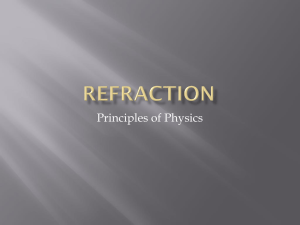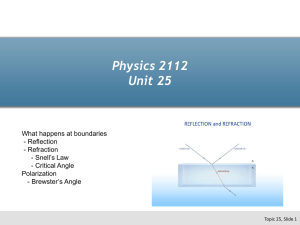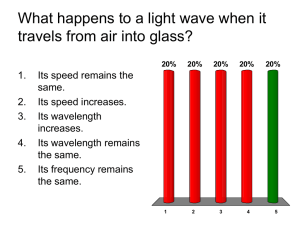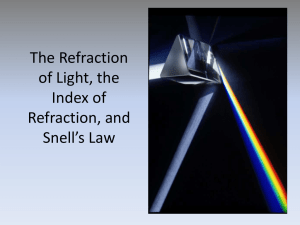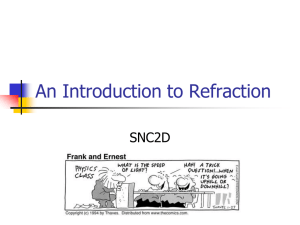Snell`s Law Refraction of Light
advertisement
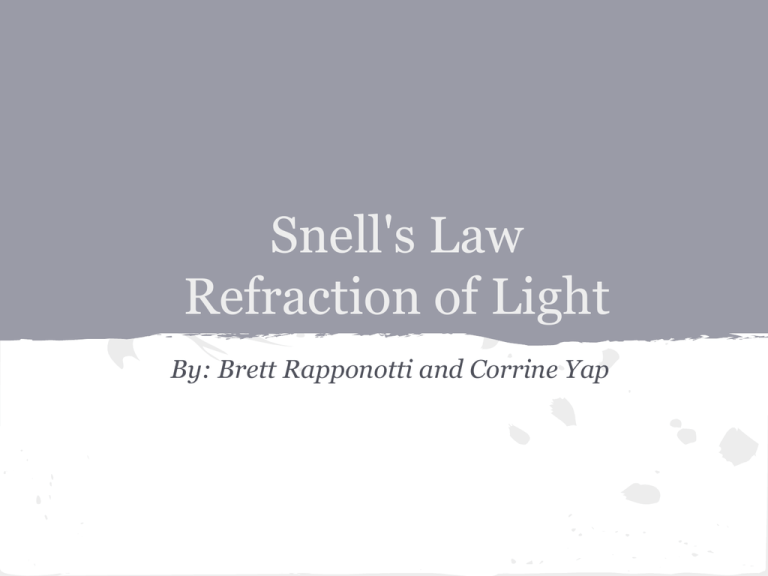
Snell's Law Refraction of Light By: Brett Rapponotti and Corrine Yap Purpose To determine the relationship between the angle of incidence and the angle of refraction of a light wave traveling through a medium. The media investigated in this experiment are air to plastic and water. Equipment Used other medium, plastic filled with water circle, divided into four quadrants, with one quadrant divided into separate ten degree sectors laser beam medium (plastic) Procedure 1. 2. 3. 4. 5. 6. 7. 8. Begin with the solid glass semicircle and align it with the diameter of the circle, facing the quadrant divided into 10o sectors. Place the laser at the “0o” position and shine it through the glass. It should follow the diameter perpendicular to the glass. Mark the light on the opposite end of the paper circle. Now place the laser at 10o. Mark the refracted light on the opposite end of the circle after it has gone through the glass medium. Repeat step 3, each time adding 10o, until 90o has been reached. Using the protractor, measure the angles of refraction. This is best done by connecting each point to the center of the circle using a ruler and then measuring the angles from the center. Plot Angle of Refraction vs. Angle of Incidence in LoggerPro. Draw semichords from the marked points to the perpendicular diameter, creating right triangles. Do the same for the original angles, and plot Semichord of Refraction vs. Semicord of Incidence. Determine the relationship between the angles and the semichords and also plot Sine of Angle of Refraction vs. Sine of Angle of Incidence. Data Graphs What Now?? The angle of incidence and angle of refraction do not have a linear relationship, although it may seem that way. So we had to find a different relationship. We decided to draw semichords from the points on the perimeter of the circle to the radii and measure them. More Graphs Thoughts... How is the semichord related to the angle, then? radius angle semichord sin(θ) = semichord/radius So..... Even More Graphs! Mathematical Analyses Sine of angle of refraction = sin(ϴR) , Sine of angle of incidence = sin(ϴI) sin(ϴR) = ksin(ϴI) k = ∆sin(ϴR)/∆sin(ϴI) kglass = 0.6532 (calculated by LoggerPro) sin(ϴR) = 0.6532sin(ϴI) Sine of angle of refraction = 0.6532*Sine of angle of incidence Hm. Now what could that possibly mean? Index of Refraction a dimensionless number that describes the relationship between the speed of light and the nature of the medium through which it travels. Index of refraction --> n speed of light --> c speed of wave --> v n = c/v nair = 1 nplastic = 1.495 kplastic (calculated by LoggerPro) = 0.6532 1/0.6532 = 1.531 Taking error into consideration, n = 1/k Therefore, sin(θR) = sin(θI)/n for plastic. WATER More on Water Even More on Water Mathematical Analysis Sine of angle of refraction = sin(ϴR) , Sine of angle of incidence = sin(ϴI) sin(ϴR) = ksin(ϴI) k = ∆sin(ϴR)/∆sin(ϴI) kwater = 0.7621 (calculated by LoggerPro) sin(ϴR) = 0.7621sin(ϴI) Sine of angle of refraction = 0.7621*Sine of angle of incidence (water) Therefore, the same conclusion can be drawn. nwater = 1.33283 kwater = 0.7621 1/0.7621 = 1.312 Taking error into consideration, nwater = 1/kwater So, sin(θR) = sin(θI)/n for water as well. But why 1? We can't just say, oh, let's divide one by the constant because it works out that way! One is a significant number. Remember that nair = 1, which is also nvacuum. The angle of incidence was measured as the light wave was traveling through air, while the angle of refraction was measured once the light traveled through a different medium. Therefore, nair = nmedium of incidence and nplastic or nwater = nmedium of refraction WHOA! sin(θR)/nI = sin(θI)/nR Rearranging, nRsin(θR) = nIsin(θI) This is Snell's Law!
